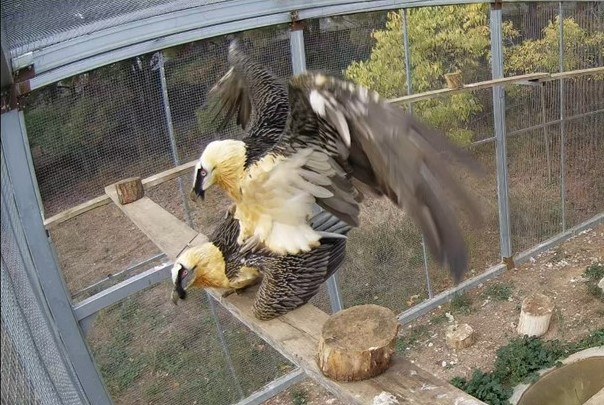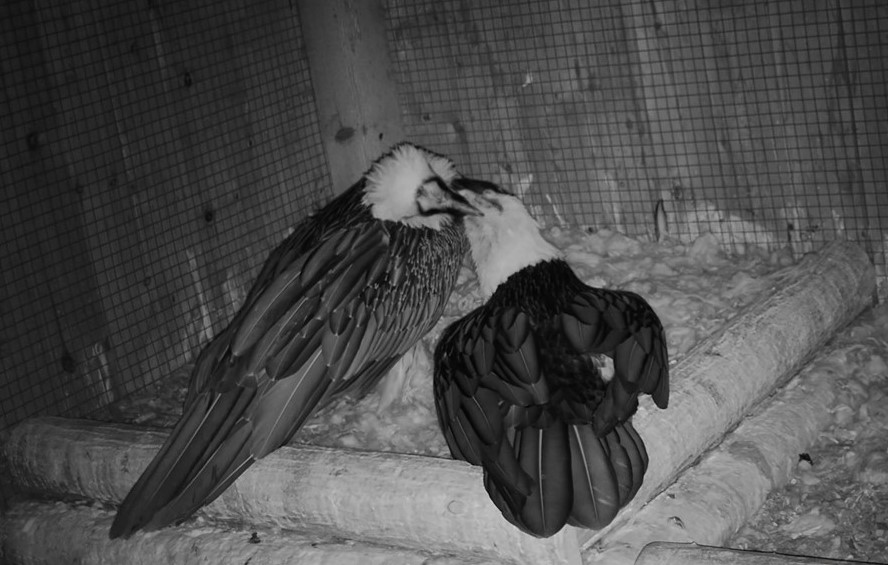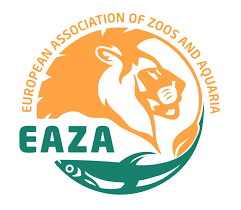
Unlike most European bird species that breed in spring, the Bearded Vulture starts its long breeding season in autumn. In fact, pairs only have a couple of months to ‘relax’ before it’s time to resume their breeding activities.
On 26 September 2022, the pair Guali and Kazorla at Torreferrusa Rescue Centre in Barcelona kicked off the new 2022/23 breeding season in captivity when they started mating. From the first signs of breeding behaviour until chicks fledge, human keepers across Europe have their hands full, supporting the needs of captive pairs to help breed as many chicks as possible and support the species’ conservation in the wild.
In this blog post, our staff from two captive breeding centres and the Coordinator of the Bearded Vulture Captive Breeding Network (Bearded Vulture EEP) give us an inside look into how they take care of pairs during the early stages of the breeding season.
The Bearded Vulture captive breeding season begins
Bearded Vultures are the earliest breeders of the four European vulture species. Known as diligent and caring parents, they have multiple parental responsibilities from the beginning of the breeding season in autumn until its end in the summer. Pairs housed within the Bearded Vulture EEP have already started exhibiting breeding behaviours, which include playing with nesting materials such as sticks and wool, constructing their nest, engaging in mutual preening, showing aggression towards neighbouring pairs and copulating.
Bearded Vulture Captive Breeding Network: a pan-European collaboration
The Bearded Vulture Captive Breeding Network, coordinated by us at the Vulture Conservation Foundation (VCF) on behalf of EAZA‘s EEP, closely works with over 40 partners, including zoos, to ensure the best breeding results from the 46 breeding pairs in captivity. Every year, we release some of their offspring to reintroduce the species to areas where it went extinct or reinforce local, threatened populations.
Captive breeding plays a massive role in the return of the Bearded Vulture to the Alps, Andalusia and Vercors. We are also reintroducing the species in Maestrazgo, the Massif Central and Pre-Alps, and reinforcing the local population in Corsica. Until the end of 2022, together with our partners, we have released a total of 381 captive-bred Bearded Vultures into the wild as part of these initiatives.
However, breeding this peculiar species in captivity is not an easy task. This is where the expertise of Dr Alex Llopis Dell comes in, who closely monitors the progress of the breeding season in Europe and supports partners in any way necessary to help achieve favourable results.
Before the breeding season starts, I remind all Bearded Vulture EEP partners what they should do during this period, such as avoid disturbances to the breeding pairs as much as possible since it’s an extremely sensitive period. They must also provide the right nesting material to help the birds rebuild their nests and ensure the nests of old pairs are not too big – in that case, they should remove a part of the nest. Human keepers can also build a nest for young pairs to encourage them to start breeding. Finally, they have to keep me in the loop about the progress, providing vital information such as dates of mating, laying, hatching, clutches sizes, potential foster pairs and so on. If they face any problems, we work together so we can try to find a solution.
Dr Alex Llopis Dell, VCF’s Bearded vulture captive breeding manager and Bearded Vulture EEP Coordinator
Guadalentín: the centre that breeds the most species
The VCF currently manages the Bearded Vulture Captive Breeding Centre of Guadalentín on behalf of the Junta de Andalucía. Today, the centre breeds the most Bearded Vultures in captivity and contributes the most chicks to reintroduction projects every year. It also specializes in double, even triple, adoptions and takes chicks from other Bearded Vulture EEP partners to naturally rear them and ensure they grow up to behave like wild birds.
As soon as we start seeing breeding behaviour from the pairs, such as mutual grooming and nest building, we start supplying the breeding pairs with sticks and wool several times a week so that they can build their nests properly. When they have plenty of nesting material in the aviaries, it encourages further breeding behaviour. In addition to this, we continuously monitor the pairs through the video surveillance system from sunrise to sunset.
Pakillo Rodríguez, Manager of the Bearded Vulture Breeding Center of Guadalentín
The centre hosts 27 birds, of which 16 form 8 breeding pairs and 4 form 2 new pairs that have not bred yet. Currently, 7 of our breeding pairs (Lázaro and Nava, Tranco and Sabina, Elías and Viola, Montero and Nona, Joseph and Keno, Andalucía and Salvia, Borosa and Toba) are already building nests and copulating. The case of the 8th couple, Cabús and Perea, is different. Perea is building the nest, but Cabús is an old male with a severe arthrosis problem since last year, which prevents him from climbing on the nest platform, so he does not collaborate in the nest building. Moreover, this health problem also disables him from jumping on the female to copulate.
Vallcallent: the centre hosting the most challenging birds


The VCF is currently managing the Bearded Vulture Specialized Breeding Unit within the Centre de Fauna de Vallcalent in Lleida, Spain, following an agreement with the Generalitat de Catalunya.
The Vallcalent unit receives birds that require additional technical support, including pairs reproducing poorly or not at all at other facilities, as well as birds that may have disabilities or are imprinted to humans. To help increase the chances of attaining healthy chicks, the centre also specializes in artificial incubation. Because of the staff’s expertise and experience, these birds have a better chance of breeding.
At this time of the year, the most important part of my job is observation because we have several handicapped birds or birds with behavioural problems. So, I monitor them very closely to record their progress or spot any problems to find a solution as soon as possible. As an example, over the last two weeks, I have been closely monitoring a pair composed of an imprinted female and a male who doesn’t copulate properly, and we were worried about the male not being able to copulate this year. Fortunately, last week, we observed the first correct mating of this pair, so we hope this development can lead to fertile clutches and even chicks!
Carmen Calero, VCF’s Bearded Vulture Captive Breeding Assistant
There are currently 13 birds at the centre, which consist of 1 experienced breeding pair, 3 breeding pairs that laid eggs before but haven’t hatched a chick yet, 1 that has never laid and 1 that is building a nest for the first time this year (immature male and mature female). The centre is also home to the famous imprinted bird Kazajo, an experienced foster father that needs to ‘pair’ with Alex and goes through the entire breeding season to adopt and rear a chick.
We want to thank all our partners who work diligently every season to help breed the species in captivity and support their conservation in the wild!








